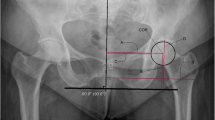Abstract
Background: Flattening of the epiphyses of long bones is seen in several skeletal dysplasias and standardized measurements on a radiograph of the knee to detect skeletal dysplasias using this feature have been described. Since then only two other studies in which this method was used have been published, and both included only a small number of children and neither had a control group. In addition, the Dutch National Working Group on Skeletal Dysplasias began to have doubts about the reliability of the method. We therefore decided to re-evaluate its accuracy in a population of children with and without a skeletal dysplasia. Objective: To determine the diagnostic value of standardized measurements on conventional AP radiographs of the knee in children with a skeletal dysplasia. Subjects and methods: We measured the distal femoral metaphysis and epiphysis according to the published method on conventional AP radiographs of the knee in 45 healthy children and 52 children with a skeletal dysplasia. We compared graphically the height of the distal femoral epiphysis with its width and with the width of the femoral metaphysis. Receiver operating characteristic (ROC) curves were calculated for each group of children. Results: All graphs showed a considerable overlap between children with a skeletal dysplasia and healthy children. The size of the area under the ROC curves for the different groups was small, varying between 0.567 and 0.653. Conclusions: This method does not discriminate between children with a skeletal dysplasia and healthy children. We therefore consider it to be of little diagnostic value.













Similar content being viewed by others
References
Taybi H, Lachman RS (1996) Radiology of syndromes, metabolic disorders and skeletal dysplasias, 4th edn. Year Book, Chicago
International Working Group on Constitutional Diseases of Bone (1998) International nomenclature and classification of the osteochondrodysplasias. Am J Med Genet 79:376–382
Hall CM (2002) International and nosology classification of constitutional disorders of bone (2001). Am J Med Genet 113:65–77
Schlesinger AE, Poznanski AK, Pudlowski RM, et al (1986) Distal femoral epiphysis: normal standards for thickness and application to bone dysplasias. Radiology 159:515–519
Van Mourik J, Weerdenburg H (1997) Radiographic anthropometry in patients with multiple epiphyseal dysplasia. Am J Roentgenol 169:1105–1108
Ingram RR (1992) Early diagnosis of multiple epiphyseal dysplasia. J Pediatr Orthop 12:241–244
Lachman RS, Krakow D, Cohn DH, et al (2005) MED, COMP, multilayered and NEIN: an overview of multiple epiphyseal dysplasia. Pediatr Radiol 35:116–123
Kohler G, Hesse B (2004) Epiphyseal dysplasia—symptoms and differential diagnostic aspects. Z Orthop Ihre Grenzgeb 142:397–402
Acknowledgements
The authors thank C.S.P.M. Uiterwaal, PhD, for his help with the data analysis and J. Senior for her assistance with preparation of the manuscript.
Author information
Authors and Affiliations
Corresponding author
Rights and permissions
About this article
Cite this article
Kwee, T.C., Beemer, F.A., Beek, F.J.A. et al. Knee radiography in the diagnosis of skeletal dysplasias. Pediatr Radiol 36, 8–15 (2006). https://doi.org/10.1007/s00247-005-0011-3
Received:
Accepted:
Published:
Issue Date:
DOI: https://doi.org/10.1007/s00247-005-0011-3




